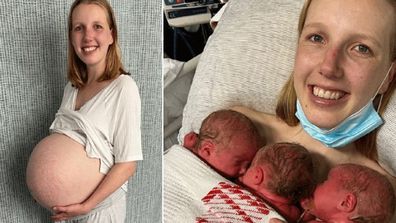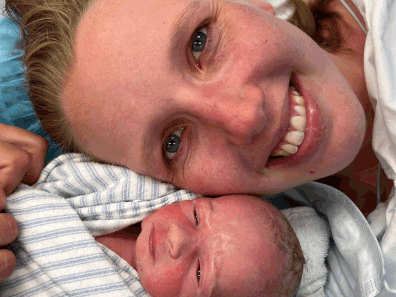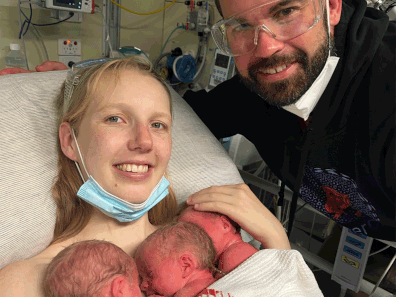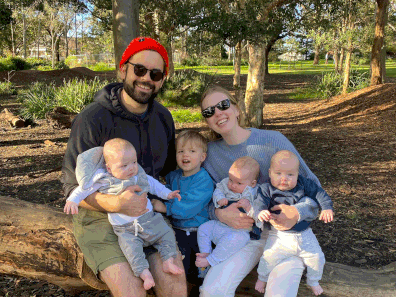In this new series we celebrate pregnancy and birth by inviting readers to share the story of their baby’s arrival.
When Silje Andersen-Cooke walked into the dating scan for her second pregnancy, she never could have imagined what was about to unfold.
The lawyer and her partner Jordan, already parents to son Mads, then 18 months, were feeling confident about this pregnancy. Thinking that, second-time-around, they knew what to expect.
Except, that is, being told there was not one, not two, but three tiny heartbeats.

Due to COVID restrictions, Silje almost attended the appointment alone, something she’s very grateful didn’t eventuate.
“I thought it was just a scan, it would be straightforward, no fuss, I’d done this before. But Jordan ended up coming and it was such a relief. I just could not hear that news alone,” she told 9Honey Parenting.
It was a first time situation for all in the room, including the ultrasound technician, who had never scanned triplets before.
“I think she probably felt a bit inexperienced to be telling us. She had the probe on my tummy and was a bit quiet initially, and it’s never good when they’re quiet,” she continued.
“She asked us how we conceived, was it IVF or spontaneously? It was such a strange question and I was really thrown and then she said ‘I’ll show you what I can see. Here’s one heartbeat’. ‘Great!’. ‘Here’s another one’. We looked at each other thinking ‘twins!’. Then ‘Here’s another one’ and I said ‘Just stop counting please, that must be it’!”
“Jordan was just laughing and thinking it was the most hilarious and amazing thing. I was completely shocked and had to see them all again.”
While Silje wanted to know everything at once – what would she have to do differently this pregnancy?; What were the risks?; Would they have to move house?, Jordan kept calm, telling her they’d work it out.

The triplets were trichorionic-triamniotic, meaning each baby had their own placenta and amniotic sac. And though the pregnancy was as straightforward as it could be with triplets – which are always considered high risk, it was physically taxing.
“I was so much bigger, quicker. By 24 weeks I looked full term and everything was stretching quickly. I had pelvic girdle pain early on and lots of Braxton Hicks contraction and puppp rash on my tummy which was so itchy,” Silje explained.
At 30 weeks Silje finished up work and, due to the risk of premature labour, tried to rest as much as possible with a toddler in tow.
Fortnightly appointments and scans with the multiples clinic at Royal Prince Alfred Hospital ensured the babies growth remained on track, but even with things going well Silje knew she may have to deliver at any point.
Due to the discomfort of a triplets pregnancy, the decision also had to be based on how Silje was coping physically.

At 34 weeks, she asked if they could consider delivering. Given she was close to the 36 week mark – the general maximum gestation for triplets, she felt they were each at the point of being ready for the birth.
“I was healthy but just wrecked and I said I can’t go any longer. I was tired and I needed a date in mind I could focus on. I wanted to reach 35 weeks, but I was just done and I wasn’t sleeping,” she said.
The hospital offered to admit her that day, but the couple chose instead to spend two more days with Mads and get in the right headspace.
A tour of the NICU also helped prepare her for the possibility of not seeing the babies after their birth, depending on their condition.

A scan on admission showed Ada, the lowest down triplet, was struggling to get nutrients. While not an urgent situation, it meant they would need to deliver soon and Silje was put on the emergency list for the following day, when the triplets would be 34 weeks, five days.
“I woke up early the next morning, and we had a room with window and there was a calm sunrise and I thought ‘Ok, I’m having three babies today, this is happening, I can do it.’
“At 2pm they were like ‘OK we’re doing it, we’re going in’. They came in with scrubs, a midwife helped me express colostrum and then I was rolled down to the operating theatre.”
It was a very calm and confident atmosphere
“I think I got the A team, a lot of people wanted to be there. There was a midwife and a pediatrician per baby and two doctors and anesthetists, a student nurse … it was a very busy room.”
“It was a very calm and confident atmosphere, there was nothing that different to my first Caesarian (with Mads). The opening was going to be the same size and because I’d already had one before I knew what to expect.”
The delivery went smoothly, with each triplet born two minutes apart. First Ada, then Teddy, then Erik. Each was an impressive weight for triplets, too, with Ada weighing 1.8kg and the boys 2.1kg and 2.3kg.

At Silje’s request, they kept track of which boy was which so the names they chose in utero matched the right baby. Although Silje was able to meet Ada, the boys both needed CPAP (ventilation) and were taken straight to the NICU.
Due to COVID restrictions, Silje could only have Jordan for support. And as he was with their babies, Silje had to recover alone.
“I could feel the anesthetic wearing off in recovery, and when I was taken up to the ward I was in so much pain already. Jordan was down with the babies, which is what I wanted. But I was stuck on the ward, pressing on the button, and I was in so much pain. I needed someone to advocate for me. I ended up texting Jordan, because I needed help.”
In the interim the babies had been settled into the nursery and Jordan had set up cameras that allowed the pair to watch them via an app. He’d also taken countless photos and videos to show her.
“He went to a lot of effort to make me feel like I was seeing them and knowing what was going on as well,” Silje said.

“Soon after he came up, I was given some pain meds that worked finally and I could breath again and focus on something other than pain and he told me about the babies, I didn’t even know what weights they were.”
“He was telling me how they were going and about their personalities in that early stage and how they looked, and we were calling close family to tell them it went well.”
Still recovering from the surgery, Silje had to be wheeled down in her bed to the NICU to visit them. Finally at 9.30pm – six and-a-half hours after their birth, she got to meet the boys.
By that time they had both been taken off their ventilators and Silje was able to enjoy her first cuddle with all three.
“They put Teddy on and then slowly another and then all three at once. It was the most beautiful moment. I had such low expectations for what I’d be able to do skin to skin wise following the triplet’s birth … I didn’t want to have any expectations in case they were hard to meet. Not many people get to do that so soon with triplets,” she said.

Silje and Jordan with their four kids. (Supplied)
“To do that on the night, within hours of their birth, was magical and I couldn’t believe how well they were doing. Ada was breastfeeding, I couldn’t believe it being that small, I was so impressed with her. It was that realisation of OK, this is what I worked so hard for: beautiful, perfect babies who are thriving. I couldn’t ask for more in that moment.”
After a few days in hospital, once Silje was deemed to be recovering well from the surgery, the couple were discharged, however the babies spent 19 days in the NICU. Staying with Silje’s parents, the pair split their time between Mads and visiting the babies, all while Silje pumped to supply their milk.
Once home, Jordan and Silje entered ‘survival mode’, working to a three hourly feed schedule through the day – Silje tandem breastfeeding two and Jordan feeing the third a bottle of expressed milk, and trying to stretch their night feeds, resettling each as they woke. Then waking the next day to do it all over, while juggling a busy toddler.
“I loved breastfeeding, but it was very physically demanding and it got very tiring and my milk supply was not going up in the afternoons, so there were lots of top ups, it got so hard, so we began weaning them at four months.”

While Silje has had help from a ‘city’ worth of family and friends to drop off food or entertain Mads, she believes more support needs to be accessible to parents of multiples. Especially for their mental health, crediting a nurse from their NICU stay who assisted the couple casually for helping them survive.
“We couldn’t do it without that help. Mentally you need to have that space and a break and it’s so important to have that assistance,” she said. “You can’t hold that many babies all the time. It’s so much work to do and while recovering yourself – you haven’t slept the night before and you’re supposed to keep going the next day. You can’t work on nothing.”
“Having the help that we established was the only reason I could just keep my mental health together, really.”
“It’s just so relentless. I wouldn’t change it, but more help would have been amazing.”